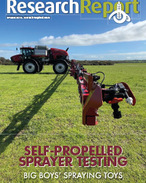This article is 6 years old. Images might not display.
The Frost Identification Guide for Canola and Pulses was produced by the Department of Primary Industries and Regional Development (DPIRD), with support from Grains Research and Development Corporation (GRDC) National Frost Initiative researchers.
The publication provides details on the identification and assessment of frost damage and is a follow-up to the Frost Identification Guide for Cereals, published last year.
Both publications feature high resolution photographs and easy to read descriptions of frost damage symptoms and plants' potential for recovery.
DPIRD research officer Ben Biddulph said early identification of frost damage would enable growers to make timely crop salvage decisions.
"The new guide for canola and pulses provides a useful reference to monitor and correctly identify whether a crop has been affected by frost or something else," Dr Biddulph said.
"The close-up photographs and comprehensive descriptions of frost symptoms for canola, lupins, field peas, chickpeas, faba beans and lentils provide good references for growers to compare and assess crop damage and severity."
The guide includes details on when to inspect crops, how to identify frost damage at the different stages of plant development, an overview of biotic and abiotic stresses that may have caused similar damage symptoms and a list of web links to more information.
The most susceptible time for frost damage in canola and pulse crops is during early flowering to late pod growth, through to early seed fill.
Frost can affect plant buds, flowers, pods, seeds and stems, which can all be present on the one plant at the same time.
Senior DPIRD research officer Mark Seymour advised canola and pulse growers to carefully inspect crops they presumed had frost damage, as these crops were susceptible for an extended period.
"Canola and pulses have an extended period of flowering and podding, which means crops can be exposed to damage for longer, however, this characteristic also provides crops with an opportunity to recover from frost," Seymour said.
"The developing seed of these crops is also susceptible to frost, although not all seed within a pod nor all pods or plants may be frosted.
"It's important for growers to monitor crops for a week or two after a frost event and to open up a lot of pods to determine the extent of damage and assess whether the crop is recovering."
The guide features details on how to report frost damage and seek advice from the department using its free MyPestGuide and PestFax Reporter apps.
The department's free online Extreme Weather Events Tool can also be used by consultants to identify regions in WA that may have been exposed to a frost event.
"Simply select the time period, temperature threshold and type of summary required to produce a map that matches the area of interest to frost criteria," Dr Biddulph said.
"This tool is particularly useful to landholders whose properties span a vast area to identify whether or not to travel the distance to inspect crops for frost damage."
The Frost Identification Guide for Canola and Pulses and the Frost Identification Guide for Cereals can be downloaded for free from the department's or the GRDC's websites, where there are more frost management tools and information. Hard copies are also available from department offices.
More details can be found at
https://www.agric.wa.gov.au/frost/frost-identification-guide-canola-and-pulses























